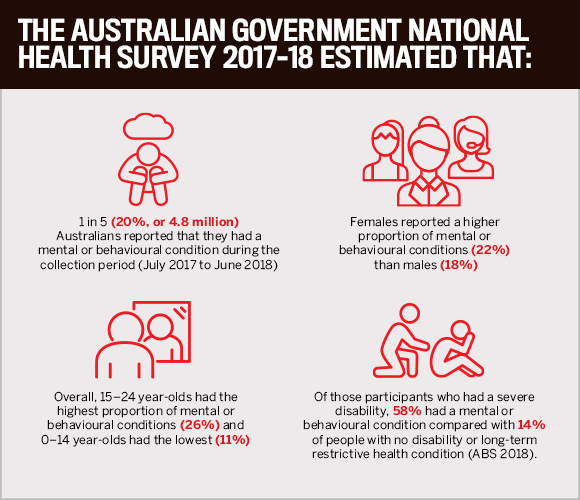
The Australian economy loses $12 billion a year due to mental health issues

The mental health of employees has risen to the top of the priority list over the past two years and looks as though it is here to stay for some time yet. The average worker spends more than a third of their waking hours at work, thereby meaning for some people it consumes their daily thoughts and time more than anything else.
According to the Black Dog Institute, the Australian economy loses approximately $12 billion per year in reduced productivity and sickness absence related to mental health issues. Working from home over the past two years has blurred the line between when the working day starts and stops, with many employers forgetting that boundaries still exist and calling or emailing with an employee anytime between 8am and 8pm is stepping outside the normal working relationship.
“With one in five Australians experiencing a mental health condition in the past 12 months, employers should be realistic that 20% of their workforce may be experiencing a mental health condition,” Liz Tully, founder and owner at Mental Health at Work, told HRD. “The most common conditions are anxiety, depression and substance use disorders, which can often co-occur in people. Stress, burnout, workload, role conflict, and meaningful work are amongst the many issues employers need to aware of to create a psychologically safe work environment.”
Another kind of stress employees are facing is the return to the office. Although many will delight at the prospect of re-connecting with employees and enjoying banter on a day-to-day and personal level, others will find the stress of the daily commute, office politics and overbearing managers harder to deal with.
“Whilst HR has a role to play in mental health, I see the wider leadership team of an organisation having a bigger part to play,” Tully said. “HR practitioners need to be educated and skilled in understanding the prevalence, impact and support available for employees but I see leaders supporting mental health awareness initiatives as more important.”
Tully believes that employers should factor in mental health sick days as they do for a physical illness. “Sadly, we often see employees not disclosing a mental illness due to stigma and a lack of clear policies and support in the workplace.”

There are many legislative requirements for employers to abide by when it comes to safety in the workplace and failure to meet those requirements can result in unwanted legal claims and damaging media coverage. It is a tricky situation to manage.
“Alongside well-known mental health concerns like depression and anxiety, working-from-home and hybrid-work models have produced a range of new mental health concerns,” Dan Auerbach, director and corporate wellbeing consultant at Associated Employee Assistance Providers, said.
“Employers need to be especially watchful for conditions caused by isolation and overwork. With staff shortages, a high workload and lack of work life boundaries, burn-out is becoming the key issue of the post COVID workplace. Employers also need to look out for signs of domestic violence due to staff members relative isolation and increases in household tensions.”
Associated Employee Assistance Providers are a leading provider of workplace mental health programs with over 700 employer members. Auerbach believes that employers need a proactive mental health policy.
“Importantly these policies need to be embedded in managerial and staff culture, so that performance related concerns for example, are considered with a mental health context in mind.,” he said. “An employee assistance provider where staff can self-refer for confidential counselling is now considered an essential.”
When it comes to observing and acknowledging an employee’s changing mental health, Auerbach says that are some tell-tale signs to watch out for.
“Changes in behaviour or output are the usual culprits to watch for, however if I were to rank the most important signs to watch for in a post Covid world, I would say first stress and overwhelm, followed by second, a lack of engagement,” he said. “These are often the result of overworking in a blended home-work environment and often point to lack of team connection and support.
“Human resources is the both the champion and the access point for a range of mental health support solutions in the organisation. Some of these measures are proactive and some are reactive. Human resources are able to support managers who note a change in behaviour or wellbeing in a staff member.”